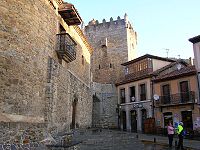.gif)
Castillo de Salas (castle)
Encyclopedia

Salas
Salas is a town and concejo in the Principality of Asturias. It lies on the road from San Sebastián to Santiago de Compostela, and on a small subtributary of the river Narcea...
in the region of Asturias
Asturias
The Principality of Asturias is an autonomous community of the Kingdom of Spain, coextensive with the former Kingdom of Asturias in the Middle Ages...
, northern Spain
Spain
Spain , officially the Kingdom of Spain languages]] under the European Charter for Regional or Minority Languages. In each of these, Spain's official name is as follows:;;;;;;), is a country and member state of the European Union located in southwestern Europe on the Iberian Peninsula...
. It first appeared in documentation in 1124.
Description
The castle is linked to the palace of Valdés Salas, which is currently a small hotel,through a bridge. The castle is a large square tower with four floors: The cellar, where the dungeons can be found, and three floors with a barrel vault. The floors are connected by a narrow spiral staircase and the roof is surrounded by battlements with a conical cylinders at each of the four corners. There are only three windows; the rest are arrow slits purely for defensive purposes. Similarly the machicolation
Machicolation
A machicolation is a floor opening between the supporting corbels of a battlement, through which stones, or other objects, could be dropped on attackers at the base of a defensive wall. The design was developed in the Middle Ages when the Norman crusaders returned. A machicolated battlement...
on the second floor, over the main gate, which was accessible over moat
Moat
A moat is a deep, broad ditch, either dry or filled with water, that surrounds a castle, other building or town, historically to provide it with a preliminary line of defence. In some places moats evolved into more extensive water defences, including natural or artificial lakes, dams and sluices...
.

